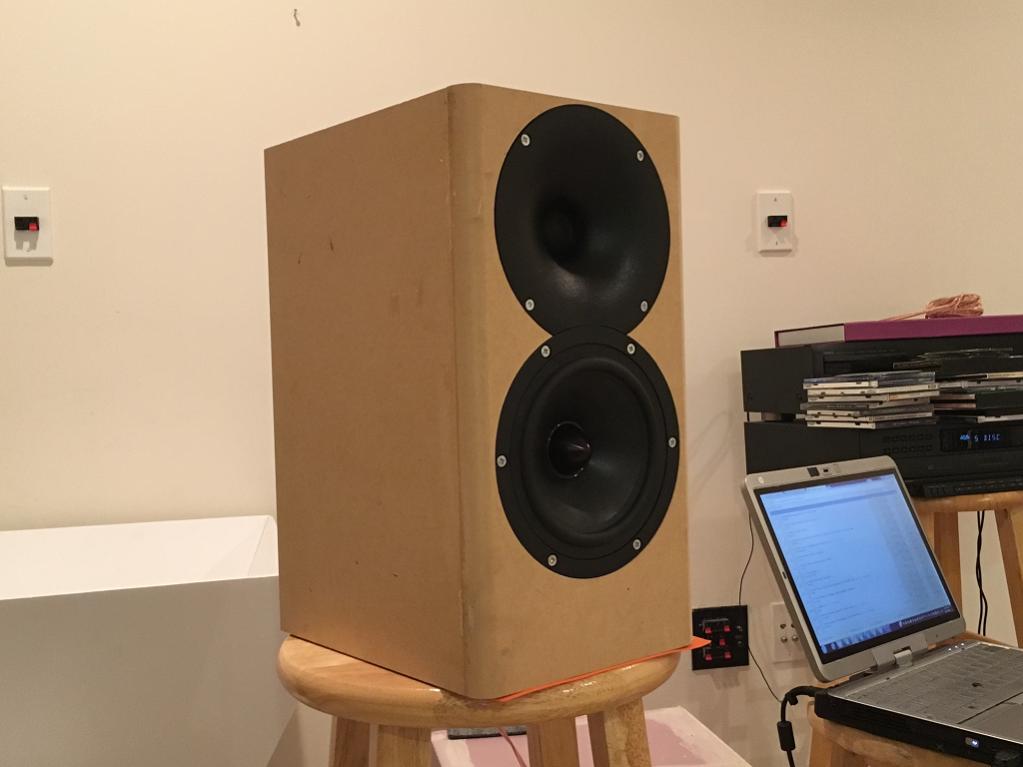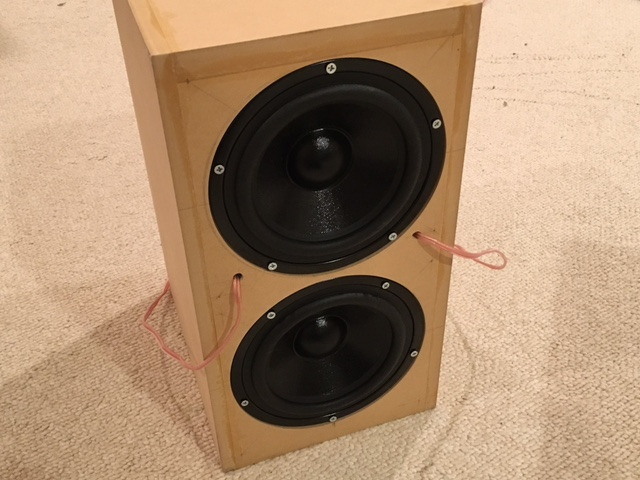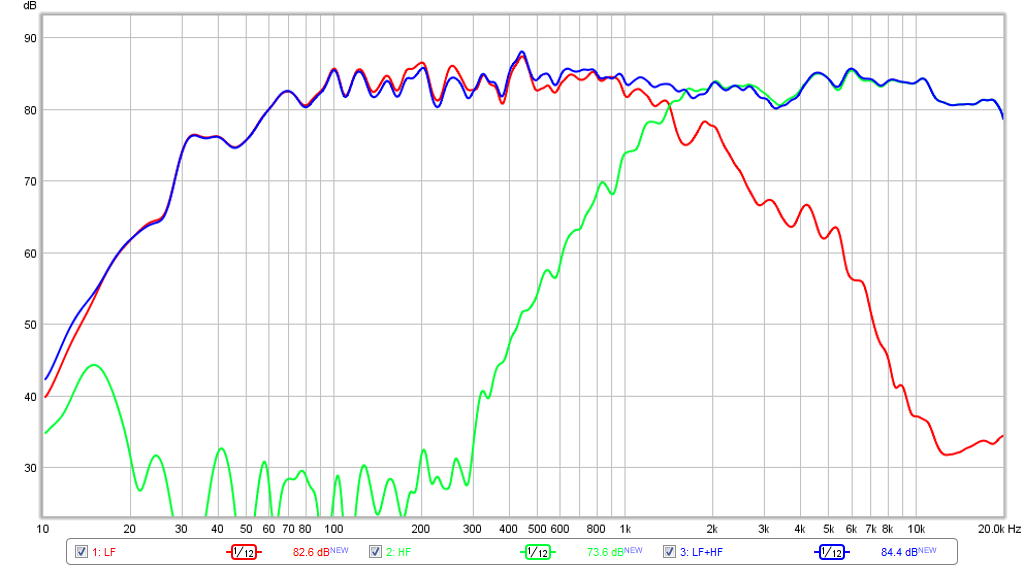I'm building a pair of 2-way bookshelf speakers using a Dayton RS180-8 woofer and a Dayton RST28F-4 tweeter.
Currently, the box volume is sitting at 0.33 cubic feet, port area is 5.55 square inches, and the port length is a whopping 19.8 inches. Based on the math and some basic 2D drawings, a slotted rear port will fold nicely inside the cabinet without displacing too much volume. Current box tuning is about 45Hz.
The goals is to keep the cabinet as small as possible (minimizing frontal area).
Without the volume displacement of the x-over components, the box volume is such that the external dimensions of the enclosure are about 8.00x12.4x10.8. Final dimensions are contingent on crossover gated measurements, tweaks in XSim, and listening tests.
Thoughts? How about that port length!? Should I be concerned about increased air resistance in the port? Will chuffing be an issue? I plan to flare the port ends with a generous round-over and incorporate radius fillers on the port 180 degree bends.
Any feedback is appreciated!
Thanks,
~Iwan
Currently, the box volume is sitting at 0.33 cubic feet, port area is 5.55 square inches, and the port length is a whopping 19.8 inches. Based on the math and some basic 2D drawings, a slotted rear port will fold nicely inside the cabinet without displacing too much volume. Current box tuning is about 45Hz.
The goals is to keep the cabinet as small as possible (minimizing frontal area).
Without the volume displacement of the x-over components, the box volume is such that the external dimensions of the enclosure are about 8.00x12.4x10.8. Final dimensions are contingent on crossover gated measurements, tweaks in XSim, and listening tests.
Thoughts? How about that port length!? Should I be concerned about increased air resistance in the port? Will chuffing be an issue? I plan to flare the port ends with a generous round-over and incorporate radius fillers on the port 180 degree bends.
Any feedback is appreciated!
Thanks,
~Iwan
Your box volume is unsuitable for a 6.5" driver, you are severely limiting the bass extension for not using an appropriate volume. Second mistake IMHO is in using a too large tube, which needs a too large length to reach your desired tuning. Unfortunately I suspect your box won't act anymore as a simple BR but as a TL. You need to simulate your box properly.
Ralf
Ralf
Box is too small for a 45hz tuning. Whether that 8” external dimension is baffle width or enclosure depth.....increase it. Don’t forget the displacement of the port must not be included as the overall internal volume of the enclosure. Once you increase the volume, port length will drop.
If I assume 3/4” cabinet material, given your dimensions after subtracting driver and port displacement I’m left with an internal net volume of under .3 curt.
Excellent drivers. Good luck with the build!
If I assume 3/4” cabinet material, given your dimensions after subtracting driver and port displacement I’m left with an internal net volume of under .3 curt.
Excellent drivers. Good luck with the build!
As a sanity check -
Plug the RS180-8 parameters in to here - HiFi Loudspeaker Design
What you will get is a Volume of 12.6l (0.45cu.ft - this is internal after removing the volume of the bracing, driver and port), Fb - 43hx, F3=48hz, and a 4cm (1.6") diam by 12.5cm (5") long port.
If you drop the volume to .33cu.ft (9.3l) you get fb=48hz, f3=52.5hz and a 6" long port.
This is only a quick check and as others have said the layout will need properly modelling to get the best results including an initial crossover design.
Plug the RS180-8 parameters in to here - HiFi Loudspeaker Design
What you will get is a Volume of 12.6l (0.45cu.ft - this is internal after removing the volume of the bracing, driver and port), Fb - 43hx, F3=48hz, and a 4cm (1.6") diam by 12.5cm (5") long port.
If you drop the volume to .33cu.ft (9.3l) you get fb=48hz, f3=52.5hz and a 6" long port.
This is only a quick check and as others have said the layout will need properly modelling to get the best results including an initial crossover design.
Thanks for the feedback!
@mayhem13 - I'll double check my calcs. The volume displaced by the port is the port structure/channel itself. The only additive volumes are the port aft baffle cutout and woofer/tweeter front baffle cutout (minus the flange thickness). I'll double check the displaced volume of the tweeter and woofer.
@giralfino - I've built TL boxes in the past. The typical line length associated with a woofer having an Fs of 35.7Hz is much longer than the what I currently have in this small 2-way. But, like you said, doubling the box volume gets me a far more reasonable port length!
General Comments: I'm using the Loudspeaker Design Cookbook, Section 2.62, and T-S parameters provided by Dayton Audio. I'm assuming a total loss (QL) of 7 and Quasi Third-Order Alignment. Transient response might suffer. I'll be measuring the free air and in-box T-S parameters myself using the DATS V2 system. I'll report back with the measured Fb. I'd like to understand the physics of the situation and learn by doing/listening.
On Parts Express' website (Dayton Audio RS180-8 7" Reference Woofer), the suggested vented box volume is 0.30 cubic feet. Determined by BassBox 6 Pro High Fidelity. I haven't used this software. Based on everyone's feedback in this forum, I'm taking that suggestion with a hint of salt
@mayhem13 - I'll double check my calcs. The volume displaced by the port is the port structure/channel itself. The only additive volumes are the port aft baffle cutout and woofer/tweeter front baffle cutout (minus the flange thickness). I'll double check the displaced volume of the tweeter and woofer.
@giralfino - I've built TL boxes in the past. The typical line length associated with a woofer having an Fs of 35.7Hz is much longer than the what I currently have in this small 2-way. But, like you said, doubling the box volume gets me a far more reasonable port length!
General Comments: I'm using the Loudspeaker Design Cookbook, Section 2.62, and T-S parameters provided by Dayton Audio. I'm assuming a total loss (QL) of 7 and Quasi Third-Order Alignment. Transient response might suffer. I'll be measuring the free air and in-box T-S parameters myself using the DATS V2 system. I'll report back with the measured Fb. I'd like to understand the physics of the situation and learn by doing/listening.
On Parts Express' website (Dayton Audio RS180-8 7" Reference Woofer), the suggested vented box volume is 0.30 cubic feet. Determined by BassBox 6 Pro High Fidelity. I haven't used this software. Based on everyone's feedback in this forum, I'm taking that suggestion with a hint of salt
I made similar speaker with 0.56 Cu ft Denovo flatpack box. I ended up using dual 6.5in passive radiators. Pretty good bass extension.
RS28F-RS180P-B80 as Hole Filler 3-way
Front w/ waveguide and RS28F:

Back side w PR’s:

With LR2 at 1500Hz:

RS28F-RS180P-B80 as Hole Filler 3-way
Front w/ waveguide and RS28F:

Back side w PR’s:

With LR2 at 1500Hz:

Thanks for the feedback!
@mayhem13 - I'll double check my calcs. The volume displaced by the port is the port structure/channel itself. The only additive volumes are the port aft baffle cutout and woofer/tweeter front baffle cutout (minus the flange thickness). I'll double check the displaced volume of the tweeter and woofer.
General Comments: I'm using the Loudspeaker Design Cookbook, Section 2.62, and T-S parameters provided by Dayton Audio. I'm assuming a total loss (QL) of 7 and Quasi Third-Order Alignment. Transient response might suffer. I'll be measuring the free air and in-box T-S parameters myself using the DATS V2 system. I'll report back with the measured Fb. I'd like to understand the physics of the situation and learn by doing/listening.
On Parts Express' website (Dayton Audio RS180-8 7" Reference Woofer), the suggested vented box volume is 0.30 cubic feet. Determined by BassBox 6 Pro High Fidelity. I haven't used this software. Based on everyone's feedback in this forum, I'm taking that suggestion with a hint of salt
So the calculations.....dimensions 12.4*10*8......therefore 11*8.5*6.5 gives net box volume 608 cin subtract port displacement (5.5 area x18) 100 leaves 508 cu/in divided by 1728 leaves .29 cu ft net volume.....not including bracing, driver displacement and crossover components.
@xrk971 - What drove you to PR's instead of a ported design? I have entertained a configuration like yours. I'll have to dig more into that thread. Thanks for the share.
PR’s offer deeper bass extension in a compact box without a long port tube - which has other issues like resonance and max port velocities to prevent chuffing etc.
I don’t think WinISD model will show pipe resonance. Akabak can model pipe resonance and of course HR can too.
So the calculations.....dimensions 12.4*10*8......therefore 11*8.5*6.5 gives net box volume 608 cin subtract port displacement (5.5 area x18) 100 leaves 508 cu/in divided by 1728 leaves .29 cu ft net volume.....not including bracing, driver displacement and crossover components.
Ok, I see the error in my ways. The volume produced by the port area swept over it's length is subtractive and needs to be added back in to compensate. Well, this is embarrassing, I wonder how I missed that. Rookie mistake. Thank you!
Ok gang. I updated my box dimensions per mayhem13's findings. Now the external dimensions are 8.00 inches wide by 12.4 inches high by 12.6 inches deep. The target volume of the box is still 0.33 ft3. I modeled this puppy in WinISD with a box tuning freq of 45.5 Hz, a 19.7 inch vent, with opening dimensions 6.50 inch x 0.85 inch. 1st port resonance is 343 Hz and the transfer function only sees a 0.5 dB rise at 90 Hz. What can I glean from all this? Note that I added 0.7 ohm in series with the driver to compensate for the added resistance caused by the woofer inductance, speaker wiring, and internal impedance of the amplifier. Also, when I check the "Use "transmission line" -model for port simulation" box, the transfer function diverges at 343 Hz.
Finally, rear port air velocity peaks around 12.66 m/s.
Any thoughts?
Finally, rear port air velocity peaks around 12.66 m/s.
Any thoughts?
- Status
- This old topic is closed. If you want to reopen this topic, contact a moderator using the "Report Post" button.
- Home
- Loudspeakers
- Multi-Way
- Bookshelf Sanity Check! RS180-8 + RST28F-4